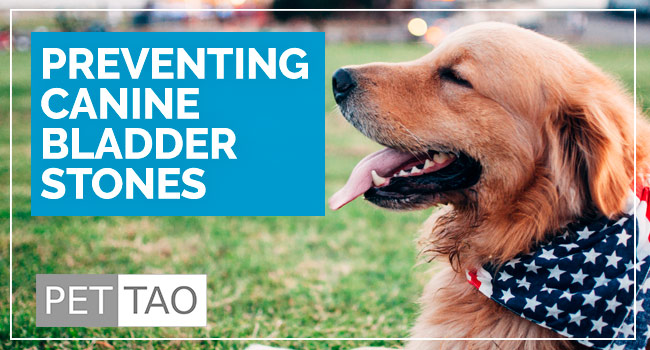Possibly, there is no health issue as debilitating as dog bladder stones.
Everyone has heard tales of the excruciating pain involved in “passing” a stone the only way it can come out.
Remember Uncle Bill at Thanksgiving dinner rolling around on the dining room floor? The pain is the same for dogs.
But dogs quietly suffer through the pain.
Knowing the causes of dog bladder stones often leads us to take proactive steps which, while seemingly pricey, actually cost far less than the purely reactive and by then necessary steps like surgery.
Also, knowing the causes and symptoms of bladders stones can help us take proactive steps that can help you avoid surgery later on.
How to Recognize the Symptoms of Canine Bladder Stones
The symptoms of bladder stones and bladder infection in dogs are the same.
The following are symptoms of dog bladder stones:
- Straining to urinate (stranguria)
- Eliminating small amounts of urine (pollakiuria)
- Squatting or hiking frequently (dysuria)
- Bloody urine (hematuria)
- Licking the private parts
- Change in elimination behaviors.
Most of the above symptoms are fairly straightforward. However, licking private parts is often not always obvious.
Licking & Staining
A more obvious result of licking is salivary staining.
When a dog licks his fur incessantly, the saliva turns your dog’s fur a golden yellow, almost rust color.
The yellow color change is called salivary staining.
Frequently originating from other diseases such as allergies, salivary staining definitely indicates some sort of problem.
For example, dogs suffering from allergies typically have some degree of salivary staining between the toes and on top of the feet; whereas, dogs suffering from urinary issues sometimes have staining between the legs.
Therefore, salivary staining between the hind limbs is most likely indicative of either allergies or urinary issues.
Excessive Drinking & Urination
Another symptom of urinary tract infection is often confused with other more serious issues is excessive drinking and urination.
The pathophysiology of this phenomenon is quite interesting, debatable, and an extraction of the phenomena in humans.
When certain bacteria, especially E.coli, establish an infection in the bladder, the bacteria set up in the bladder wall and upon bacterial death release an endotoxin.
The endotoxin causes many physiologic derangements.
Regarding the kidney, the endotoxins affect the kidney’s ability to reabsorb water which is needed and required by the body.
The ultimate loss of water manifests as increased urination.
And in order to recoup lost water, your dog drinks more.
We call increased urination polyuria (PU). We call increased thirst polydipsia (PD).
Other causes of PU/PD are renal failure, high calcium, Cushing’s disease, diabetes, and excessive salt intake.
Furthermore, endotoxins alter the effects of vasopressin, an antidiuretic hormone responsible for water maintenance and balance.
Recognizing the symptoms is important; however, knowing the causes of dog bladder stones is even more important in avoiding pain and suffering.
Powerful Tools to Help Your Dog’s Urinary Tract & Bladder Challenges
There are many quick and easy changes you can make at home to help your give your dog an edge on easing urinary tract challenges.
- Learn more about dog bladder and kidney stone health challenges.
- Provide bladder support. PET | TAO Soothe Bladder is a blend of Eastern herbs and Western supplements working together to soothe your dog’s bladder and urinary tract.
- Consider a Cooling Diet. PET | TAO Chill cools inflammation caused by infection. Make sure to discuss any dietary changes with your holistic vet.
- Try PET | TAO Freeze Dried Beef Kidney Treats. According to TCVM, kidney controls kidney, bladder, and urinary tract functions. As few as 5-6 treats per day can make a huge difference in your urinary tract and bladder health!
- Learn more about TCVM Herbal Remedies. Chinese medicine offers many amazing natural solutions for canine bladder and urinary health challenges. Some good examples are:








